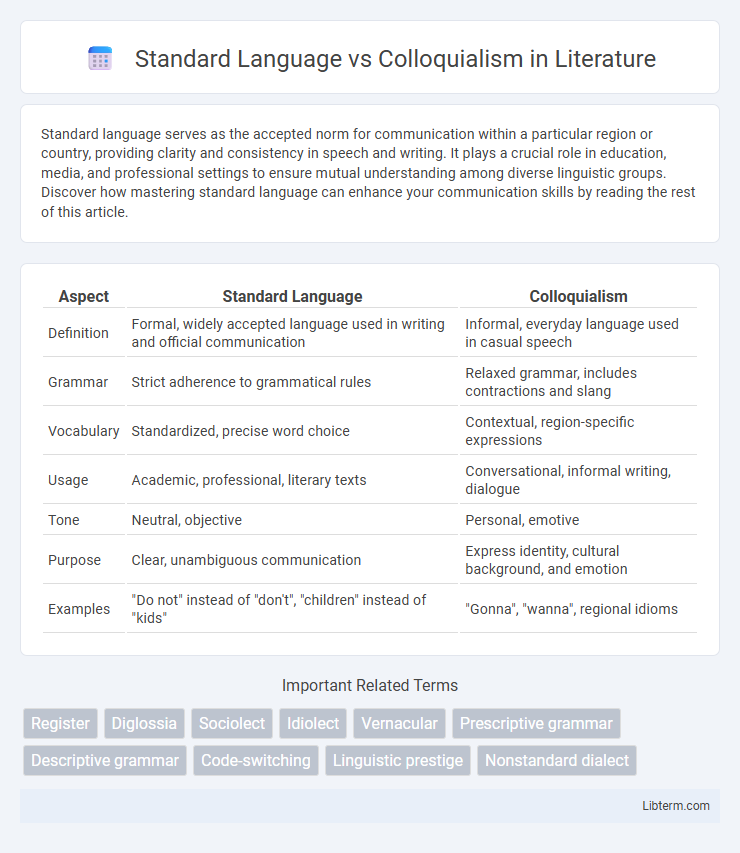Standard language serves as the accepted norm for communication within a particular region or country, providing clarity and consistency in speech and writing. It plays a crucial role in education, media, and professional settings to ensure mutual understanding among diverse linguistic groups. Discover how mastering standard language can enhance your communication skills by reading the rest of this article.
Table of Comparison
| Aspect | Standard Language | Colloquialism |
|---|---|---|
| Definition | Formal, widely accepted language used in writing and official communication | Informal, everyday language used in casual speech |
| Grammar | Strict adherence to grammatical rules | Relaxed grammar, includes contractions and slang |
| Vocabulary | Standardized, precise word choice | Contextual, region-specific expressions |
| Usage | Academic, professional, literary texts | Conversational, informal writing, dialogue |
| Tone | Neutral, objective | Personal, emotive |
| Purpose | Clear, unambiguous communication | Express identity, cultural background, and emotion |
| Examples | "Do not" instead of "don't", "children" instead of "kids" | "Gonna", "wanna", regional idioms |
Introduction to Standard Language and Colloquialism
Standard language represents a formal, widely accepted version of a language used in official communication, education, and media, characterized by fixed grammar and vocabulary norms. Colloquialism includes informal expressions, slang, and idiomatic phrases specific to particular regions or social groups, often reflecting cultural identity and everyday speech. Understanding the distinction between standard language and colloquialism is essential for effective communication across diverse contexts and audiences.
Defining Standard Language
Standard language is a formally recognized dialect used in official communication, education, and media, characterized by consistent grammar, vocabulary, and pronunciation. It serves as a benchmark for correctness and clarity, facilitating mutual understanding across diverse linguistic communities. Unlike colloquialism, which reflects informal, regional, or cultural speech patterns, standard language maintains uniformity essential for formal contexts.
Understanding Colloquialism
Colloquialism refers to the informal language used in everyday conversation, often characterized by slang, idioms, and regional phrases that differ from the more formal standard language. Understanding colloquialism involves recognizing context-specific expressions that convey cultural nuances and social relationships, which are rarely found in standard language textbooks. Mastery of colloquial language enhances communication effectiveness in casual settings and helps decode meaning in native speakers' speech and informal writing.
Historical Development of Standard vs Colloquial Forms
The historical development of standard language forms emerged through the codification of grammar, spelling, and usage norms often influenced by political and cultural centers, such as the rise of the London dialect in Early Modern English. Colloquialism evolved simultaneously as informal, regionally varied speech patterns reflecting everyday communication and oral traditions outside formal educational contexts. Over time, the tension between preserving standard language for official and literary purposes and acknowledging colloquial expressions in social identity has shaped modern linguistic landscapes.
Key Characteristics of Standard Language
Standard language is characterized by its consistent grammar, vocabulary, and pronunciation, used widely in formal writing, education, and official communication. It serves as a uniform medium for clear and precise expression, minimizing regional or social variations. This form emphasizes correctness, codification, and broad acceptability across different dialect-speaking populations.
Features of Colloquial Language
Colloquial language features informal vocabulary, contractions, and idiomatic expressions that reflect everyday speech patterns. It often includes slang, regional dialects, and simplified grammar structures, making communication more direct and relatable. Such language is context-dependent, emphasizing spontaneity and social interaction rather than strict adherence to grammatical rules.
Contexts for Using Standard and Colloquial Language
Standard language is typically used in formal contexts such as academic writing, professional communication, and official documents where clarity, precision, and universality are essential. Colloquial language thrives in informal settings like casual conversations, social media interactions, and storytelling, providing a relaxed and relatable tone. Choosing between standard and colloquial language depends largely on the audience, purpose, and medium of communication to ensure effective message delivery.
Impact on Communication and Misunderstandings
Standard language ensures clear and consistent communication across diverse audiences by adhering to accepted grammatical norms and vocabulary, reducing the risk of misunderstandings. Colloquialisms, while enriching expression and fostering familiarity, can create barriers when interlocutors are unfamiliar with regional or cultural nuances, leading to confusion or misinterpretation. Effective communication requires balancing standard language's clarity with colloquial language's relatability to minimize potential misunderstandings.
Role in Education and Professional Settings
Standard language serves as the preferred medium of instruction and communication in education and professional settings, ensuring clarity, uniformity, and mutual understanding among diverse speakers. Colloquialisms, while valuable for cultural expression and informal interaction, can hinder comprehension and professionalism when used in formal academic or workplace environments. Mastery of standard language enhances academic success, effective collaboration, and career advancement by aligning communication with institutional expectations.
Standard Language and Colloquialism in Media and Pop Culture
Standard language in media ensures clear communication and broad accessibility, often used in news broadcasts, documentaries, and formal interviews to maintain professionalism and credibility. Colloquialism in pop culture, including films, music, and social media, adds authenticity and relatability by reflecting everyday speech and regional dialects, enhancing audience engagement. The dynamic interplay between standard language and colloquial expressions shapes cultural identity and influences language evolution in contemporary media landscapes.
Standard Language Infographic

 libterm.com
libterm.com